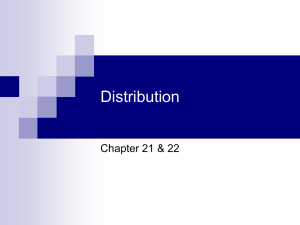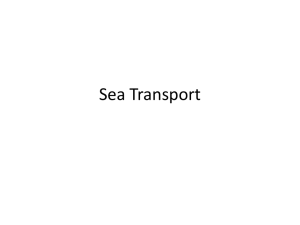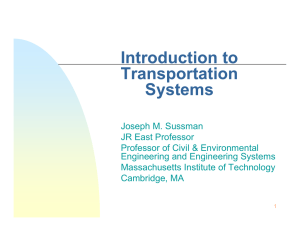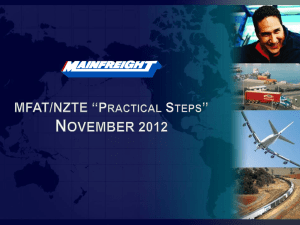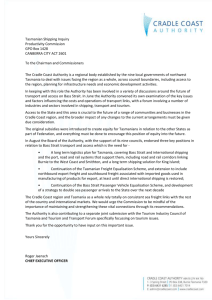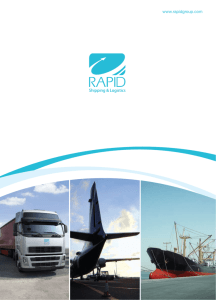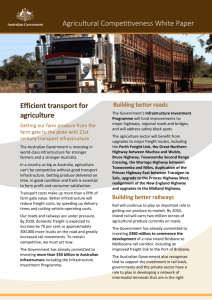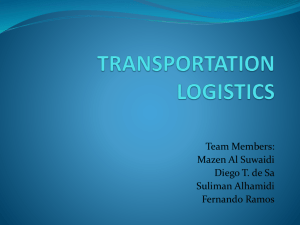Chapter 6 Additional Notes
advertisement
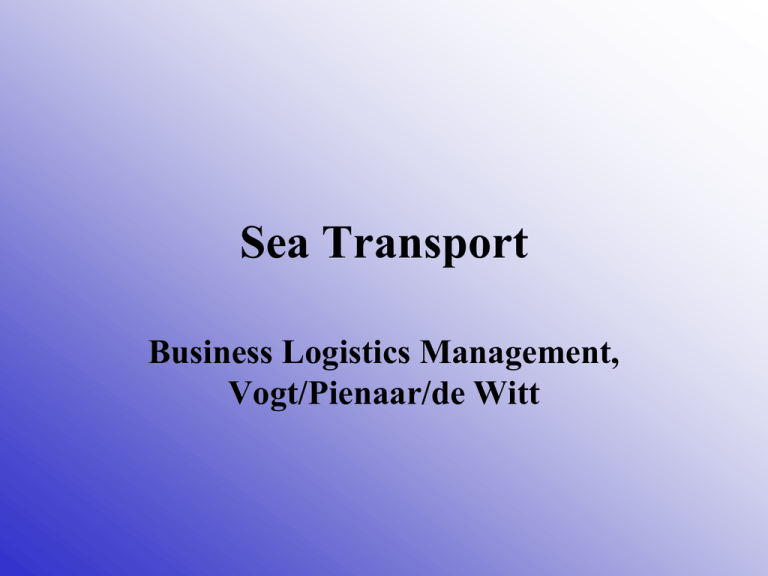
Sea Transport Business Logistics Management, Vogt/Pienaar/de Witt Operational overview • Ocean carriage is the most cost-effective way of transporting high-bulk commodities over long distances and is therefore the most widely used international shipment method. • It is used for both inbound and outbound shipments, although there is usually an unbalanced flow of freight. • The development of large bulk carriers has enabled sea transport to assume a vital role in the transportation of bulk materials such as ores and minerals, grains, and timber products; and especially coal, crude oil, and petroleum products between energy-producing and energy-importing countries Operational overview cont’ • Water transport is often limited to international deep-sea transport and coastal shipping between local ports. • Inland water carriers are dependent on the availability of navigable lakes, rivers, and canals. I • n North America, Europe, and Asia, for example, a significant portion of the total intercity freight tonnage is transported on inland waterways by river barges and small vessels. Operational overview cont’ • Shipping has become highly specialised since the 1960s, each type of specialist ship being designed to be more productive than the ship it replaces. • Specialisation has resulted in ships becoming complementary to other modes of transport in the Logistics chain. • They are therefore often designed for a specific trade route and commodity type, with little prospect of employment on other trade mutes. Operational overview cont’ • Bulk carriers carry cargoes with low value-toweight ratios, such as ores, grain, coal, and scrap metal. • Tankers (mostly crude oil vessels) carry the largest amount of cargo by tonnage. • Roll-on/roll-off (Ro-Ro) ships carry cargo that is driven directly onto the ship, and allow for standard road vehicle trailers to load and unload cargo. Operational overview cont’ • Oil-bulk-ore (OBO) vessels are multipurpose bulk carriers able to carry both liquid and dry bulk products. • Container ships have greatly expanded the use of sea transport for many commodities. Most international shipments involve the use of internationally standardised containers suitable for intermodal carriage. Typical strengths of Sea Transport • A low-cost service can be supplied. • Large volumes of high-density freight can be conveyed over long distances. • Standard intermodal containers can be utilised to facilitate freight handling and transhipment. • Traffic congestion is virtually non-existent on the open sea. • Sea transport offers a very safe and secure service. Typical limitations of Sea Transport • Service can only be rendered to and from sea-ports that have the facilities to receive the ship and conduct the required transhipment. A door-to-door service is therefore not possible. • Because transhipment is unavoidable at both ends of a voyage, more freight handling takes place than with other surface transport modes. Typical limitations of Sea Transport cont’ • Ships are vulnerable to inclement weather and stormy sea conditions. This can delay delivery and in some cases prevent it altogether. • Sea transport offers a slow and lowfrequency service. Freight characteristics • Almost any kind of freight can be conveyed by ship at a relatively low cost. • Short delivery times are not of critical importance as far as the vast majority of commodities that are transported by ship are concerned. • Clients make a trade-off between long transport times and the relatively low tariffs offered by sea transport. Competition within Sea Transport • Ocean shipping competition range from open competition, as in the case of tramp shipping (individual ships seeking cargo), to oligopolistic cartels, as in the case of liner shipping conferences. • A liner shipping conference is a number of ships from various shipping lines working on a route in conference, or sharing the loads on the route. Competition within Sea Transport cont’ • As is the case with air transport, economies of scale are possible with large individual vessels and not necessarily with large fleet operations. • Single-ship operators, for example owners of tramp ships, are therefore able to compete with larger scheduled conference liners. Sea Transport Cost Structure • The cost structure of sea transport is similar to that of air transport. • It is characterised by a high proportion of variable costs due to the fact that the way the means of transport involved (the sea) does not require investment and seaports are not owned or supplied by shipping firms. • Expenses in ports can be as high as forty per cent of sea transport costs. • However, these obligations only arise when a port is visited. Fixed costs Overhead costs • general overheads (management, administration, and office commitments); • marketing costs (advertising, sales costs, and agents’ commission); and • marine costs (land administration directly involved in shipping activities). Standing costs • maintenance and repairs; • vessel inspection and check-ups (usually every four years); • insurance; • depreciation; • fixed crew costs (unless contracted for individual voyages); • radio and communication dues; and • auxiliary stores aboard. Variable costs Variable costs of shipping are voyage-specific and include: • fuel; • crew costs (when contracted for individual voyages); • port and other terminal costs; • insurance to cover risks on the water, • maintenance relating to motion; • freight (all costs associated with freight storage, loading, stowing, and unloading); and • miscellaneous sailing costs. END
